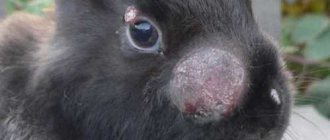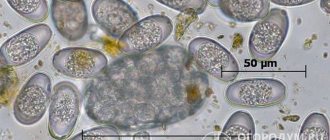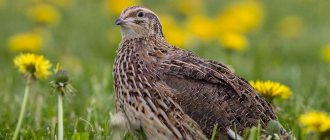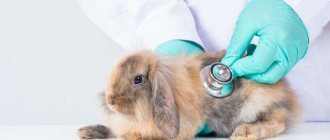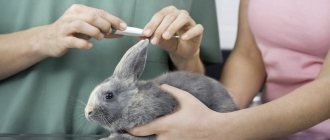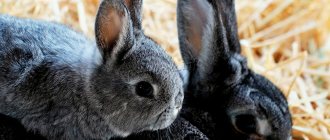Diseases of the liver and biliary tract in rodents and rabbits
The liver is one of the most important organs in the body; it is involved in all metabolic processes occurring in the body. Its main functions include:
- Protein metabolism
- Carbohydrate metabolism
- Lipid metabolism
- Vitamin exchange
- Hormone exchange
- Pigment exchange
- Neutralization of toxic substances
- Immune protection
- Circulation
- Digestive function
Lesions of the liver and biliary tract make up a significant percentage of animal diseases, including rodents and lagomorphs, diagnosed in a veterinary clinic.
Diseases of the liver and biliary tract found in rodents and rabbits:
- Non-inflammatory diseases - hepatosis (fatty, amyloid)
- Inflammatory diseases - hepatitis (acute and chronic, primary and secondary)
- Cirrhosis of the liver
- Liver neoplasms
- Liver abscesses
- Circulatory disorders in the liver
Biliary tract diseases:
- Cholecystitis - inflammation of the gallbladder
- Cholangitis - inflammation of the bile ducts
- Cholelithiasis - formation of gallstones
Often the diseases can occur in combination.
The most common causes of liver and biliary tract diseases in rodents and rabbits:
Clinical symptoms of liver and biliary tract diseases in rodents and lagomorphs:
- Lethargy
- Refusal to feed
- Weight loss
- Increased or decreased thirst
- Dry mucous membranes
- Flatulence
- Diarrhea
- Constipation
- Dermatitis, itching, dry skin, dandruff formation, alopecia on the skin, hyperkeratosis
- jaundice
- ascites - accumulation of free fluid in the abdominal cavity
- stool discoloration – hypocholia
- change in urine color (dark beer-colored or bright yellow urine)
- decreased blood clotting and the appearance of hemorrhages on the skin
- colicky pain
Diagnosis of liver diseases is carried out comprehensively in a veterinary clinic, including anamnesis, clinical signs, palpation and percussion examination of the animal, laboratory tests to assess the functional state of the liver, and additional research methods - x-rays, ultrasound.
Life history - carried out to collect data about the period of the animal’s life preceding the disease.
Owners need to answer the following questions:
- age of the animal
- conditions of detention
- completed vaccinations (for rabbits)
- contact with other domestic animals or wild rodents
- detailed diet composition
- was there a change in diet and living conditions?
- time and nature of manifestation of the disease
- course of the disease (sharp or gradual deterioration of the condition, course with spontaneous remissions)
- change in appetite
- change in thirst
- changes in stool and urine
- dynamics of animal condition
- increase in abdominal volume
- change in animal behavior
- changes in coat quality and skin condition
During a clinical examination, attention is paid to the appearance of the animal:
- position of the animal's body in space
- constitution
- fatness
When examining mucous membranes and skin, special attention is paid to:
- presence of icterus, anemia
- tendency to hemorrhage
When palpating the abdominal wall of the animal, the following is noted:
- soreness
- increase in liver size
- edema and ascites
- pneumatosis of the gastrointestinal tract
Biochemical blood test (main indicators that are assessed in rodents and lagomorphs for diseases of the liver and biliary tract):
- Total protein
- Albumen
- AST
- ALT
- GGT
- LDH
- Bilirubin
- Alkaline phosphatase
The standard set of indicators in rodents includes the first 5 indicators, the rest are optional, if it is possible to take a sufficient volume of biomaterial.
Hematological studies can detect only nonspecific changes that occur in liver diseases. Reveal:
- increased erythrocyte sedimentation rate (ESR)
- leukopenia
- leukocytosis (neutrophilia)
- thrombocytopenia
- microcytic, macrocytic or hemolytic anemia
- change in hematocrit value
Urine examination is carried out for the presence of urobilin and specific crystals.
X-ray examination is used to evaluate the size of the liver and detect ascites.
- Tumors, hypertrophic cirrhosis, and excess load are accompanied by an increase in liver volume.
- Atrophic cirrhosis leads to a decrease in the boundaries of the liver.
- An increase in the X-ray contrast of the organ can serve as an indicator of liver pathology.
Ultrasound examination is used for:
- determining the size and volume of the liver,
- foci of echogenicity,
- visualization of the bile ducts,
- determining the presence of suspension or stones in the gall bladder,
- detection of ascites, incl. with a small accumulation of fluid
- control of liver biopsy, but is rarely used in rodents and rabbits.
Tactics for treating liver diseases
1. Elimination or reduction of activity of the etiological factor (cause)
2.Detoxification of the body (enterosgel, enterodesis)
3.Correction of water and electrolyte balance (sodium chloride, ringer, ringer-locka, rehydron, hydrovit)
5. Lactulose (ammonia binding, laxative effect): Duphalac, Lactusan, Lactofiltrum
6.Hepatoprotectors (Karsil, Heptral, Essentiale, Liv52, Hofitol, Hepatovet)
7.Vitamins and amino acids (Dufalite, Hemobalance)
Treatment tactics for biliary tract diseases
1. Elimination of the etiological factor or reduction of its activity
Read also: What water to feed rabbits
3. Relieving spasms of the biliary tract (no-spa, papaverine, atropine, buscopan)
4. Choleretic drugs (Ursofalk, Hofitol, Cholenzym, Holosas, Tykveol, corn silk)
5. Choleretic products in the diet (dandelion leaves, dill, spinach, celery; cabbage, tomatoes, carrots, Jerusalem artichoke, beets, grapefruit, orange, sour apples, oat bran, rose hips)
Prevention of liver and biliary tract diseases
- Balanced feeding
- Absence in the diet of potentially dangerous foods that can cause poisoning - exotic fruits and vegetables, succulent food of unknown origin, especially in winter and spring.
- Preventive measures (anthelmintics, coccidiostatics)
- Optimal living conditions, spacious cage – prevention of obesity
In a minimal amount, pathologies of the liver and biliary tract are detected in the summer, when the natural diet predominates - freshly dried hay, grass, vegetables and fruits from one’s own garden.
In guinea pigs, pathologies associated with damage to the liver and biliary tract account for approximately 20% of the total number of diseases, in rabbits about 10%, in rats and chinchillas about 5% (according to data from 2014). In other rodents, liver disease is not always possible to diagnose due to the small size of the animal and the difficulty of taking blood tests and performing ultrasound.
Diseases of the bile and hepatic ducts and their manifestations
Causes of diseases of the bile ducts:
- parasites;
- tumors of the mucous membrane and submucosal layer;
- heterogeneous consistency of bile;
- damage to the duct by calcifications.
The main risk group is women, because they are more likely than men to experience hormonal problems and suffer from excess weight.
Blocked ducts
Most often, the ducts become blocked due to cholelithiasis. Obstruction can also be caused by a tumor, inflammation of the walls of the ducts, a cyst, helminthic infestation, or a bacterial infection. Narrowing of the ducts (strictures)
The main reason for this pathology is a previous operation to remove the gallbladder or tumor, cyst in the duct. Inflammation persists for a long time after surgery, which leads to narrowing. The patient loses appetite, experiences pain in the right side, and his body temperature rises.
Screeds and scars
The walls of the duct are replaced by scar tissue due to inflammation caused by sclerosing cholangitis. As a result, the outflow of bile is disrupted, it is absorbed into the blood and stagnates in the gallbladder. There are no symptoms, but as the disease progresses, liver cells die.
Swelling
The walls of the bile ducts become denser due to catarrhal inflammation. In this case, overcrowding of the blood vessels occurs, the mucous membrane of the duct swells, leukocytes accumulate on the walls, and the epithelium exfoliates. Often this disease becomes chronic. At the same time, he constantly experiences discomfort in the right side, he is tormented by nausea, and vomiting occurs.
Cholelithiasis
Stones in the biliary system are formed due to stagnation of bile in the gallbladder and disruption of cholesterol metabolism. For treatment, medications are prescribed, under the influence of which the stones leave the gallbladder through the ducts. The patient feels a stabbing, cutting pain in the right side. A large stone may partially or completely block the duct. This is called gallbladder spasm. Its symptoms are pain, nausea, vomiting.
Tumors and metastases in cancer
Klatskin tumor is often found in older patients with biliary problems. In 50% of cases, a malignant tumor forms in the common bile duct. If left untreated, metastases appear, affecting regional lymph nodes, pancreas, and liver. The disease can be detected at an early stage if the symptoms are not ignored: pain in the right hypochondrium, which radiates to the neck and shoulder blade.
Parasites
Trematodes, Giardia, and flukes may appear in the gallbladder and ducts. They cause chronic inflammation of the walls of the gallbladder and disrupt the contractile function of the ducts.
Free or paid treatment?
Dyskinesia
With this disease, the consistency of contraction of the walls of the gallbladder and its ducts is disrupted. As a result, bile enters the duodenum in deficiency or excess, which disrupts the process of digestion and absorption of nutrients.
Cholangitis
Inflammation of the bile ducts occurs when they become blocked or liver secretions become infected with bacteria. There are three types of inflammation:
- acute, occurring unexpectedly - a person has a headache, the skin turns yellow, a stabbing pain appears in the right hypochondrium, which radiates to the shoulder and neck;
- chronic – mild pain on the right side, increased body temperature, bloating of the upper abdomen;
- sclerosing - there are no symptoms, and if left untreated, liver failure develops, which cannot be cured.
Extension
Most often it occurs due to increased contractility of the walls of the gallbladder. There are other reasons - blockage of the common duct with a tumor or stone, improper functioning of the sphincters. As a result, the pressure in the biliary system increases and the ducts expand.
Biliary atresia
This is a blockage or absence of the bile ducts. The disease is found in newborns. The child's skin becomes yellow-green, the urine darkens, and the feces become white-gray. If the pathology is not treated, the child will not live more than one and a half years.
Rabbit coccidiosis
Coccidiosis is an invasive disease caused by single-celled parasitic protozoa - coccidia, accompanied by damage to the intestines and liver.
In rabbits, coccidiosis is caused by 10 species of coccidia that parasitize the intestines and liver of rabbits. Nine out of ten species of coccidia in rabbits parasitize the intestinal mucosa, and one species parasitizes the liver. Intestinal coccidia cause the intestinal form of coccidiosis, and the hepatic coccidia cause hepatic coccidiosis. Usually, rabbits suffer from simultaneous intestinal and hepatic coccidiosis.
Coccidia oocysts are resistant to environmental factors. At a temperature of 80-100oSoocysts die within 5-10 seconds. Disinfectants have little effect on oocysts. Coccidiosis in rabbits is widespread, especially in rabbit farms. The disease is registered all year round, worsening in the spring and summer.
Rabbit coccidia only infects rabbits. The greatest susceptibility is observed in young animals up to 3-4 months of age. Adult rabbits rarely suffer from the clinical form of the disease, remaining carriers of coccidiosis.
infected through the nutritional route through food, water, and milk contaminated with coccidia oocysts. Rabbits become infected from the first days of life - when sucking milk from their mother's nipples contaminated with coccidia oocysts, and subsequently - with food and water contaminated with feces containing the causative agent of coccidiosis, as well as when eating feces.
In a rabbit farm, an outbreak of infection is caused by a violation of veterinary and sanitary rules for keeping and feeding rabbits:
The incubation (latent) period for coccidiosis lasts 2-3 days.
Signs of the disease:
When opening dead rabbits with intestinal coccidiosis, they find in the intestinal mucosa a large number of small (the size of a poppy seed to a millet grain) whitish nodules that contain a large number of coccidia oocysts. The intestinal mucosa itself
The diagnosis is made comprehensively, taking into account the epizootic state of the farm, clinical signs of the disease, postmortem examination data and the results of microscopic examinations of feces or pathological material when examining the affected organs in a veterinary laboratory.
Treatment.
Treatment begins with the elimination of all deficiencies in feeding and keeping rabbits, as well as predisposing factors.
The best method of treating coccidiosis in rabbits is considered to be the use of iodine preparations , which, being the strongest antioxidant, once in the body of rabbits contribute to the oxidation and neutralization of toxic protein breakdown products that have not been oxidized during the digestion process and inhibit the development of coccidia. Iodine additionally, through the animal’s thyroid gland, has a stimulating effect on the entire animal’s body.
Considering that infection of baby rabbits occurs from the first days of life when sucking the nipples of a rabbit infested with coccidia oocysts, the female is given iodine preparations from the last days of pregnancy so that the baby rabbits receive it through the rabbit’s milk from the first days of life.
Leontyuk recommended a method of treating young animals with iodine solutions. Iodine solutions are given to animals in the morning before food is distributed (they are poured into drinking bowls instead of water) according to the following scheme:
The above iodine solutions should be given to sick rabbits according to the same scheme, regardless of whether they received it while under females or not.
To prepare a 0.01% iodine solution, pour 1 ml of 10% or 2 ml of 5% iodine tincture into 1 liter of water. Rabbit breeders should know that it is impossible to prepare iodine solutions in metal containers.
Sulfonamide drugs are used to treat cococidia: sulfadimethatoxin, norsulfazole, phthalazole, sulfapyridazine, ditrim, metronidazole. Nitrofuran drugs are also used for coccidiosis.
Read also: Do rabbits get rabies?
Sulfadimethoxine is given orally at 0.2 g per 1 kg of rabbit live weight on the 1st day and 0.1 g in the next 4 days. Then we take a 5-day break in treatment and repeat the course of treatment again.
Norsulfazole is given together with phthalazole - orally at the rate of 0.3-0.4 g of norsulfazole and 0.1 g of phthalazole per 1 kg of rabbit live weight, daily for 5 days. After a 5-day break, the course of treatment is repeated.
are used for the treatment and prevention of coccidiosis .
For a week, rabbits with coccidiosis are given furazolidone (30 mg per 1 kg of rabbit live weight, or 0.05 g per kilogram of feed). Furazolidone does not completely destroy coccidia in the body of a sick rabbit, but has a sufficient therapeutic effect.
Rabbit breeders need to keep in mind that during the period of using coccidiostats in the rabbits' diet, it is necessary to increase the dose of vitamins A and B1.
To increase the effectiveness of treatment, fermented milk products are included in the diet of rabbits: yogurt, whey, ABA (acidophilic broth culture).
The same medicinal product cannot be used for a long time on the same rabbit farm, because Coccidia develop strains that are resistant to most medications, and after 1-2 years, previously effective coccidiostats lose their preventive and medicinal properties in a given farm.
Control measures.
When fighting coccidiosis, rabbit breeders must consider the following:
The rabbit breeder must remember that rabbits that have recovered from coccidiosis remain carriers of the pathogen, for this reason they are sent for slaughter. The meat of such rabbits is suitable for food.
The rabbit breeder must purchase new rabbits only from farms that are free from coccidiosis, according to a veterinary certificate of form No. 1-vet or a veterinary certificate of form 4-vet (if the rabbits were purchased within the region), which will indicate that the rabbits were tested for coccidiosis during the quarantine period before sale in veterinary laboratory and they have received the necessary vaccinations against infectious diseases.
When a new batch of rabbits arrives at the farm, they must be quarantined (for 30 days) and during this period a coprological test for coccidiosis must be carried out in a veterinary laboratory.
Coccidiosis in rabbits
Coccidiosis is a disease caused by single-celled parasites called coccidia. They have a damaging effect on the condition of the animal’s liver and intestines. Young rabbits aged 3-4 months are most susceptible to this disease. But still, adults are not immune from this dangerous infection.
Experts say that the parasites of this disease are present in the body of a rabbit from the first days of its birth, just as a person is born with worms and other helminths. The presence of coccidia in an animal’s body does not pose any particular danger; the main thing is not to allow or create conditions for their active reproduction, development and appearance of the disease coccidiosis.
The organ affected by coccidia will no longer be able to function normally. As a result, part of the food consumed cannot be digested, and all useful components will not be absorbed in the body. For this reason, the sick rabbit begins to lose weight, the body becomes exhausted and eventually dies.
Read also: Rabbit hair loss: reasons, what to do, how to treat
Sources and factors of infection
Many coccidia cysts are found in the feces of infected animals. Sometimes pathogens spread through feces to surrounding objects and food, which can ultimately lead to infections of other healthy individuals. Therefore, the main source of infection for coccidiosis is considered to be contact and fecal-oral.
The initial stage of coccidiosis in rabbits
Sources of coccidiosis infection include:
- Through feed mixtures, water, and also through milk, which contains mature coccidia;
- Infection through the feces of infected individuals;
- From other animals that are carriers of the disease virus;
- Milk from a nursing rabbit that is infected with the disease;
- Various rodents, birds, insects;
- Tools, uniform of farm workers.
Animals often become infected with the disease on farms where workers are careless about their care and do not comply with appropriate sanitary standards. Sometimes animals living in uncleaned cages eat feces that contain coccidia and subsequently become infected.
You may also be interested in the following rabbit-related articles:
Factors that contribute to the development of the disease:
- Keeping rabbits in one cage in a crowded state;
- Failure to comply with quarantine standards during the acquisition of new individuals;
- If the cells are located in an incorrect position, which allows the penetration of rodents or birds carrying infectious agents into them;
- Failure to comply with sanitary and veterinary rules for keeping these animals.
The disease is not spread by airborne droplets; it is epidemic in nature. Its spread is explained by the fact that when pathogenic organisms get on equipment, work clothes of farm workers, feeders, feed and other items, they are quickly transferred to animal cages.
As a result, all offspring that live in these cells become infected. Coccidia are resistant to aggressive substances; sometimes even disinfection does not help remove these parasites. The only thing that kills these parasites is treating the room with hot water.
Types of disease
Depending on the area of distribution of infectious agents, the disease can be of the following types:
- Intestinal coccidiosis;
- Hepatic coccidiosis.
The symptoms of these types of infections vary. To prescribe the correct treatment, it is necessary to know the symptoms of the two types of coccidiosis in order to identify it in time and begin treatment immediately.
Rabbit with coccidiosis
Importance of the liver for the body
The liver is one of the most important organs in any living organism, in addition to the well-known detoxification (neutralizing toxic substances) function, the following depend on it:
- Metabolic functions (exchange of vitamins, fats, proteins, hormonal metabolism).
- Circulatory function.
- State of the immune system.
- Digestion.
- Pigmentation.
Liver disease in rabbits can manifest itself with the development of many pathological processes, ranging from metabolic disorders associated with nutrition and ending with viral diseases, especially in the chronic form, since in the acute form, pathological disorders simply do not have time to develop.
Infectious diseases
Viral diseases in rabbits are considered almost always fatal. Frequently encountered:
Pasteurellosis is a disease that quickly affects all rabbits on the farm. The source of the virus is considered not only to be a sick rabbit, but also to infected food and water. Symptoms: sharp deterioration in body temperature; increased heart rate and breathing. After a few days, the individual’s temperature drops by 7-10 degrees, which indicates imminent death.
Myxomatosis is the most terrible and incurable disease. The rabbit swells within a few days, acquiring an inflamed muzzle and mucous membranes, and dies after 10 days.
Tularemia is a disease difficult to identify without a medical examination and the necessary tests. First, inflammatory processes pass through all the lymphatic pathways, infecting all the walls of the mucous membrane along the way.
Over time, ulcers appear on the infected areas, which eventually burst, causing pain to the rodent. Rarely do rabbits survive from this infection, but if they do, the animal gains strong immunity.
All types of contagious diseases can be found on the Internet, as well as photos of symptoms of rabbit diseases. Photographs are often repulsive with a sickening appearance, but it is important to know the “enemy in person” in order to be able to fight it.
Diseases of the liver and gall bladder in rabbits
Since these two organs are closely interconnected, liver diseases in rabbits very often occur simultaneously with the pathology developing in the gallbladder:
- Inflammation of the gallbladder (cholecystitis) and bile ducts (cholangitis).
- Stone formation (cholelithiasis).
- Inflammation of the liver (hepatitis, acute and chronic).
- Impaired metabolism and nutrition in liver cells (fatty and pigmented hepatosis).
- Replacement of liver cells with connective tissue (cirrhosis).
- Tumor formations (neoplasms) and abscesses (ulcers).
- Circulatory disorders.
The most common diseases accompanied by liver damage
- Inflammation of the gastrointestinal tract, poisoning (poor quality feed, lack of milk in the rabbit) - diarrhea with mucus, bloating, constipation.
- Parasitic diseases
- Eimeriosis (coccidiosis) - caused by protozoa, manifested by exhaustion, digestive dysfunction; upon autopsy, light, nodule-like inclusions containing the pathogen are found in the liver. Enlargement of the bile ducts and growth of connective tissue may also be detected.
- Cysticercosis or finnosis is a helminthic infestation caused by the larvae of flatworms, for which rabbits are intermediate hosts. Manifested by inflammation of the liver (hepatitis) and peritoneum (peritonitis). The source of infection is dogs, which are the definitive hosts.
- Another common helminthic infestation is hepaticolosis, which is caused in rabbits by the larvae of roundworms developing in the liver. After the development and death of the parasite, connective tissue grows in the liver (cirrhosis). Pigs, cats, dogs and rodents can get sick. The most common source of infection is rats.
- Infectious diseases
- The most common viral disease accompanied by liver damage in rabbits is hemorrhagic disease.
- Liver damage is also observed in the following diseases: pasteurellosis, listeriosis, colibacillosis, staphylococcosis and others.
Read also: Ovarian cyst in a cow
How do chickens become infected with coccidiosis?
The most common reason is the conditions in which poultry are kept:
- dirty drinking bowl. Water can become the main source of infection of the entire livestock;
- high temperature and humidity in the chicken coop, as these conditions promote the proliferation of coccidia. Therefore, chickens get sick more often in spring and summer;
- dirty feeders, which often contain chicken droppings;
- litter It must be changed after winter, and also if one sick chicken is found;
- contaminated equipment;
- a cramped poultry house in which young animals are in close contact with adults;
- a poor diet that weakens the body’s defenses;
- synanthropic (wild, garbage bird) flying into the yard, since the garbage bird is a carrier.
Diagnostics
When carrying out diagnostics, clinical signs, data from laboratory tests, additional examinations (radiography, ultrasound), and pathological changes are taken into account. In decorative rabbits, a clinical and biochemical blood test is performed (the main indicators are ALT, AST, bilirubin, albumin, total protein, alkaline phosphatase), and a urine test.
Basic principles of treatment of liver diseases:
- Removal of intoxication (subcutaneous administration of saline and glucose, oral administration of enterosorbents, use of hepatoprotectors - drugs that normalize liver function).
- Elimination of the cause of the disease (antiviral and antimicrobial therapy, anthelmintics).
- Normalization of intestinal function (pro- and prebiotics).
- Preparations containing amino acids and vitamins (Dufalite and others).
- Diet feeding (low protein).
The importance of liver for a rabbit
One of the most important organs of any living organism is the liver.
It performs a number of very important functions necessary to maintain the normal condition of the animal:
- detoxification - neutralization of toxic substances;
- normalization of metabolic processes - hormonal and fat metabolism, protein and vitamin metabolism;
- circulation;
- normalization of the immune system;
- normalization of the digestive system.
Liver diseases can occur against the background of various pathological processes, ranging from disruptions in the functioning of the digestive system associated with poor nutrition, and ending with viral and infectious diseases, especially those in a chronic form, since acute pathology does not have time to develop.
Possible diseases
The causes of liver disease can have different origins, depending on the factors causing the disorders:
- non-contagious , appearing as a result of intoxication of the body;
- infectious - developing under the influence of toxins caused by viruses or bacteria;
- invasive - the sources of which can be the waste products of helminths and other parasites.
Let's look at the most common liver diseases in rabbits.
Inflammation of the gastrointestinal tract
For treatment, the veterinarian prescribes special medications. You may also need to massage the abdominal walls or use an enema in case of constipation.
Parasitic diseases
Often, liver diseases occur due to the harmful effects of various parasites.
There are several parasitic diseases:
Eimeriosis or coccidiosis is the result of exposure to protozoan organisms.
Its main symptoms are:
- exhaustion of the body;
- disorder of the digestive system;
- periodic bloating;
- loss of appetite, depressed state;
- sudden weight loss;
- the appearance of seizures.
The disease has an acute and chronic course. The incubation period is 2–3 days. In treating the disease, drugs based on Sulfanilamide are most effective.
Cysticercosis, or finnosis : a disease that is caused by the larvae of cestodes (flat worms) and is characterized by the development of hepatitis and peritonitis. Dogs, which are the final hosts of parasites, are considered to be the source of pathogens.
Factors contributing to the development of the disease are considered to be violation of sanitary standards when keeping animals and poor quality feeding. Mice or rats can become sources of infection. To date, the symptoms of the disease have not been fully studied. There are also no accurate methods for diagnosing it.
Infectious diseases
Diseases of rabbits photo and description
The most common diseases of rabbits.
Raising pets is undoubtedly not only a rewarding but also an enjoyable process. However, like people, all our smaller brothers are susceptible to diseases. This is especially true for rabbits. Rabbit meat is a dietary and tasty product and is highly valued, while the efforts spent on breeding these animals are quite serious. Rabbits, even if all the rules of rearing are observed, can unexpectedly become infected with a disease and it is sometimes quite difficult to cure them, given the fact that some diseases develop rapidly and, in addition, are incurable, losing all the rabbits is quite realistic and disappointing. The ideal option is to vaccinate animals against diseases, as well as closely monitor them during especially dangerous periods, namely in spring and autumn.
Signs of illness.
A healthy animal has a good appetite and good mood. He is very active, his coat is soft and silky, and his urine is thick. If the animal begins to refuse food, suffers from indigestion, behaves sedentary, and accumulations of mucus appear in the eyes, then these are clear signs of illness. In addition, symptoms of the disease include high fever, frequent shallow breathing, crumpled hair, drooping ears, rapid heartbeat, and discharge from the nose, ears and eyes. Sometimes animals develop bumps. In this case, it is necessary to immediately take measures for treatment, the first of which is the separation of sick individuals from the general mass. Sometimes the disease is incurable, then the animals must be slaughtered, but first you must make sure that the disease is not dangerous to humans.
Cysticercosis.
A parasitic disease that dogs can suffer from. The disease can be noticed at a serious stage of infection and develops very rapidly. The animal can die after just six days. Young individuals under the age of three months are most susceptible to this disease. When the animal becomes ill, it begins to feel depressed, its activity decreases, its stool is loose, and the rabbit itself rapidly loses weight. It is recommended to carry out prevention in the form of adding a special granule to the food, and already sick animals are treated with homeopathic or homotoxicological drugs.
Pasteurellosis.
An infectious disease that can affect birds, domestic animals and humans. It has rapid development and two forms. The atypical form is treated and goes away on its own after a few months. Purulent abscesses appear on the animal’s body. At the same time, the rabbit feels normal and does not change its behavior in any way. The typical form is incurable. In this case, the animal’s temperature rises sharply and drops before death. Sometimes diarrhea appears, the animal breathes frequently, and may refuse to eat. A sick rabbit should be killed, its bedding, remaining water and food should be destroyed, and the cage should be disinfected. The remaining rabbits need to be given anti-infective drugs, which are administered intramuscularly.
Scabies.
The causative agent of scabies is a mite that settles in the skin layers of the head or inside the ear. The mite feeds on blood, which causes scabies in the animal. It begins to refuse to eat, rapidly loses weight and dies. Symptoms include small wounds and small scabs. The treatment is treatment of wounds with turpentine, which should be done every five days. In addition, the cage must be disinfected, and waste products and food destroyed.
Fascioliasis.
The disease can be caused by the small pond snail mollusk. To avoid disease, it is necessary to refrain from using water from natural reservoirs, as well as feeding grass in which the pond snail can live. The disease is easily treated, but manifests itself in the form of increased heart rate, swelling in the eyelids, and sometimes in the jaw. Areas of fur become dull and fall out. The mucous membrane of the mouth and eyes takes on a yellow tint.
Listeriosis.
One of the most dangerous diseases, incurable. Sick animals must be killed, the cage must be disinfected, and everything with which the animal has been in contact must be burned. The disease has three forms and most often affects pregnant females. In rare cases, they survive, but are no longer able to have offspring. Depending on the form, the disease can kill a rabbit in at least two days, maximum in a month. May spread to people. The disease is infectious and affects the liver.
Myxomatosis.
Another dangerous disease. Accompanied by swelling, the appearance of gelatinous nodules throughout the body, as well as conjunctivitis. During the disease, the animal's head begins to swell, redness appears in the eyelid area, and the ears droop. If the disease does not quickly go away on its own, conjunctivitis with purulent discharge will soon appear. In this case, the animal cannot open its eyelids, and pus may enter the nose, causing difficulty breathing with wheezing. After a few weeks, necrosis appears at the site of the nodules.
Tularemia.
Many animals, as well as humans, are susceptible to the disease. May occur in an implicit form. It is natural in nature and appears in the form of outbreaks, that is, the entire livestock becomes ill. The disease may be accompanied by fever, swollen lymph nodes, and possible paralysis. Sometimes there are no external signs. The disease is an isolated case, that is, after recovery it will never return. The younger generation of animals is often infected. Spreads through food and drink, and in summer from insect bites.
Infectious rhinitis.
The disease can be caused by microbes that are always in the rabbit's nose. When the nasal mucosa is injured, it penetrates the body and causes illness. Death is possible if microbes penetrate deep into the body. Sick rabbits practically do not change their behavior, and the disease itself may not go away for a year. The nose is clogged and often swollen. The animal constantly rubs it, which spreads the infection further. Treated by nasal drops.
Viral hemorrhagic disease (VHD).
This disease is considered incurable and vaccination is necessary for prevention. The entire livestock is exposed to it, so the disease is one of the most dangerous. The unpleasant fact is that the disease can withstand low temperatures, can live for five years, and develops in four days, after which the animal dies in a matter of hours. The disease can be transmitted through contaminated food, the skin of a sick rabbit, and clothing. If the VGBV has killed all the rabbits, then everything associated with them must be destroyed so as not to put the new plant at risk. The disease causes diathesis in the animal's organs, such as the lungs and liver. At the final stage, yellowish and blood-red discharge from the nose is observed. Spreads from old individuals to young ones.
Non-communicable diseases.
Rickets.
Rickets often appears in young rabbits whose diet does not contain enough vitamins and minerals. Accompanied by curvature of the spine and sometimes the limbs. When the disease appears, it is necessary to immediately change their diet.
Pneumonia.
This is the most common disease. Rabbits are very sensitive to changes in temperature, humidity and drafts. The rabbit becomes inactive, its body temperature rises, and its breathing is wheezing and difficult. Sometimes you may experience nasal discharge.
Conjunctivitis.
This disease can develop after small particles get into the eyes. It has a purulent and catarrhal form. The second, if launched, goes into the first. The mucous membrane of the eye becomes red and swollen, and tears are produced. With a purulent disease, pus is discharged and cataracts may develop.
Pododermatitis.
Damage to the soles of the feet. This disease develops in rabbits that are overweight and have slightly swollen paws. The most common cause is mesh floors. The sole of the animal becomes covered with wounds, and if pathogens enter it, the disease can take a severe form. A sick animal is forced to lie down a lot and its appetite decreases, which leads to rapid weight loss of the individual.
These are not all diseases, but they are among the most common and dangerous. In addition, rabbits can suffer from lice, which is accompanied by itching and accordingly the rabbit scratches the affected areas. Animals can have worms, a very unpleasant disease that is difficult to identify. It can last for years, and all this time the worms will parasitize the animal.
To avoid diseases, you should adhere to the rules for keeping rabbits, provide their diet with all the necessary nutrients in the form of supplements and vitamins, and also conduct examinations of rabbits in order to detect the disease in time and prevent it from spreading.
How to treat liver disease in rabbits
Treatment of liver diseases involves taking various medications.
First of all, therapy is aimed at:
- removal of intoxication of the body;
- normalization of the function of the digestive system;
- increasing protective properties by taking vitamin-mineral complexes.
Also, in some cases, treatment with traditional methods is indicated.
Medications
When taking any medications, in order to prevent the development of complications, the rabbit must be provided with plenty of fluids.
Traditional methods
Among folk remedies for the treatment of liver diseases in rabbits, including coccidiosis, the method using iodine has gained the greatest popularity. Iodine is a remedy that has excellent antiseptic and antioxidant properties.
How can you treat sick animals?
How and with what to treat coccidiosis in rabbits? Coccidiosis is well treated with medications. Medicines against this disease are sold in many veterinary pharmacies. They are used for treatment and prevention.
During the use of medicines, infected individuals are placed in a separate cage. The cage in which sick animals are kept is disinfected and steamed with hot air. If treatment is started from the first days of the onset of the disease, then the chances of recovery will be much higher. With timely treatment, the survival rate is 75-80%.
How to give the medicine (how to dilute and in what dosage)?
Coccidiosis in rabbits is treated with the following medications:
- Vetom;
- Baycox;
- Sulfadimethatoxin;
- Sulfapyridazine;
- Phthalazol;
- Furazolidone;
- Solikoks.
The drug Solikox for the treatment of coccidiosis in rabbits
Rules for the use of medications:
- Sulfadimethatoxin, Sulfapyridazine. The medicine is given with water. It is added to drinking water. On the first day, 0.2 grams of the drug are given per 1 kilogram of the animal’s body weight; in the next 4 days of treatment, 0.1 grams of the drug are given per 1 kilogram of the animal’s body weight. After this, you need to take a break for 5 days and then repeat the treatment again;
- Phthalazol. To enhance the effect, it is better to use this drug together with Norsulfazole. The affected individual is given 0.3 grams of Norsulfazole and 0.1 grams of Phthalazole per 1 kilogram of rabbit weight. The course of treatment with these drugs should be approximately 5 days. After this, you need to take a break for 5 days and the treatment is repeated again;
- Furazolidone. During coccidiosis, give the affected rabbit 30 mg of the drug per 1 kilogram of body weight every day. The course of treatment is a week;
- Baycox. This remedy is considered the most effective in the treatment of coccidiosis. It always has a positive effect and in most cases helps to completely cure this terrible infection. Many experienced rabbit breeders claim that even advanced stages of coccidiosis can be cured with this remedy. The instructions for this product indicate several methods of use. You can inject 2 cubes of the drug into an infected individual and then pour the medicine into the drinking bowl at the rate of 0.2 ml per 1 kilogram of animal weight. Sometimes the medicine is diluted with water and, according to the instructions, it is administered to the infected animal in a dosage of 10 ml once a day. The exact use can be clarified at a veterinary pharmacy or study the instructions for use in detail;
- Levomycetin and Sulfadimezin. Sometimes, with coccidiosis, an animal can be given a solution of chloramphenicol, this drug is given in a dosage of 40 grams, or the drug Sulfadimezin can be given in a dosage of 150 mg.
Read also: Aggressive rabbit - why rabbits can be evil
Rules for the use of other drugs for coccidiosis in rabbits can be found in the instructions for them. Usually the instructions describe in detail the characteristics and rules for taking the drug.
Treatment with folk remedies (iodine)
Many experienced rabbit breeders claim that treatment of coccidosis in rabbits is also possible with folk remedies, for example, with the help of iodine. It stops the active development of coccidia and causes the oxidation of those substances that remain unprocessed by the stomach.
Rules for treating coccidiosis with iodine for rabbits:
- On the 25th day of pregnancy, females are given a 0.01% iodine solution in a dosage of 100 ml every day;
- On the 5th day after the birth of the cubs, iodine must be removed from the diet, on the 5th day it is returned again;
- Individuals should be given iodine for another 15 days. Every day you need to give a 0.02% iodine solution in a dosage of 200 ml. As a result, not only the mother rabbit, but also the rabbits themselves are protected from infection, because they receive iodine together with their mother’s milk;
- Be sure to immediately feed the baby rabbits from the mother rabbit with a 0.01% iodine solution. Every day, one individual should be given 50 ml of iodine solution;
- After 10 days, the iodine solution should be removed from the diet;
- After about 5 days, you need to feed the animals again with iodine solution. Drink with 0.02% iodine solution in a dosage of 100 ml. The course of treatment should be 15 days.
